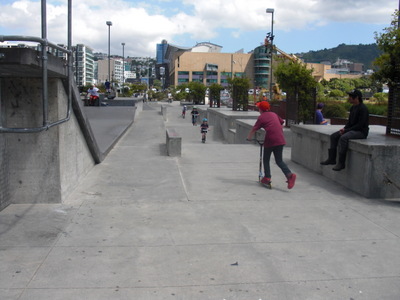
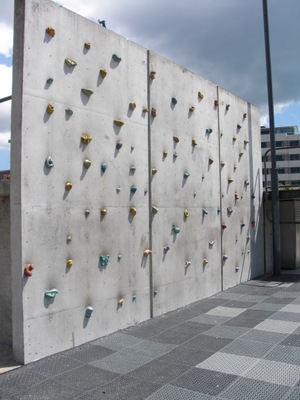 Eventually, I narrowed the choices to three stores within reasonable walking distance, then confirmed my choices by checking with the desk clerk, who ranked them from cheap to upscale.
Eventually, I narrowed the choices to three stores within reasonable walking distance, then confirmed my choices by checking with the desk clerk, who ranked them from cheap to upscale.Monday, 3 December 2012: Wellington, Zealandia
Our hotel, the Bay Plaza, offered only two breakfasts. The very inexpensive "continental" buffet included only cereals, milk, juice, fruit (canned and fresh), hot drink of choice (no decaf coffee), and toast. I'm not sure what continent they had in mind. The "cooked" breakfast, for a whopping $19.00, added to that a huge plate of English-style eggs, sausage, bacon, tomatoes, mushrooms, potatoes, etc. No option available for someone who wants, e.g., just the eggs, some cheese, or a real continental breakfast.
While David practiced his talk, I tried to research places to buy luggage—a snap on the internet, but a real nuisance for a person shopping on foot, given only a phone book that covers several municipalities and that doesn't include a street map.

 Eventually, I narrowed the choices to three stores within reasonable walking distance, then confirmed my choices by checking with the desk clerk, who ranked them from cheap to upscale.
Eventually, I narrowed the choices to three stores within reasonable walking distance, then confirmed my choices by checking with the desk clerk, who ranked them from cheap to upscale.
I walked with David the two long blocks to Te Papa, so as to see the meeting venue and find out where I should look for him later. Along our route was a large park that apparently hosts open vegetable markets on weekends (but we were never there on the right days) and provides a large skate, scooter, and climbing park. This long undulating course was popular with kids on scooters, and a couple of good-sized climbing walls were available. The mat at the bottom looks thin, but walking across it revealed that it covers quite a deep cushioned pit.
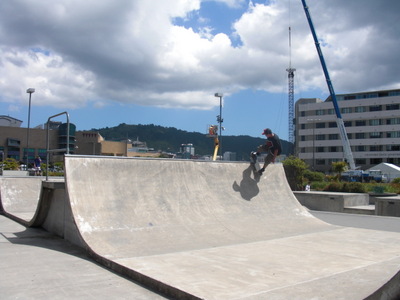
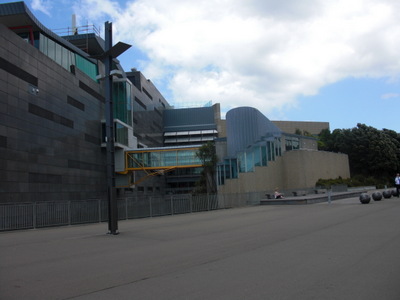 Between the scooters and the street (but still separated from traffic by a very wide sidewalk and a row of trees) were several half-tubes and other shapes for skateboarding.
Between the scooters and the street (but still separated from traffic by a very wide sidewalk and a row of trees) were several half-tubes and other shapes for skateboarding.
At the right is Te Papa itself, viewed from a different direction (you can see the side that faced our hotel in the background of the skateboard photo, at the left-hand side. It's big, and the entrance was on the other side, so just having to walk past it to get in added almost another block to the distance.
After exploring the meeting venue, and acquiring a visitor's pass (in lieu of meeting nametag, since I wasn't actually registered for the meeting), I set off for a department store called Briscoe's (with a stop at the Salvation Army store, which I happened to pass, but they didn't have what I needed), I bought quite a nice suitcase. It's huge, and I had no alternative but to abandon my smaller one at the hotel when we left town, so I'll eventually have to acquire another for those situations in which I'm permitted to carry two—I much prefer to use two smaller rather than one so large.
After wheeling it back to the hotel, I went off to the city's tourism office (called the I-Site, for "information site," pronounced "eyesight") in Civic Square. There, I grabbed some lunch at their cafeacute" (an undistinguished sausage roll and pastry) and bought a CityPass, which was good for admission to my choice of two out of three attractions (the observatory, the zoo, and Zealandia—I chose the latter two) plus a round trip (actually two one-ways, to be used together or separately) on the cablecar, a cable-actuated inclined railway that runs from downtown up the steep slope to the top of the hills behind the city.
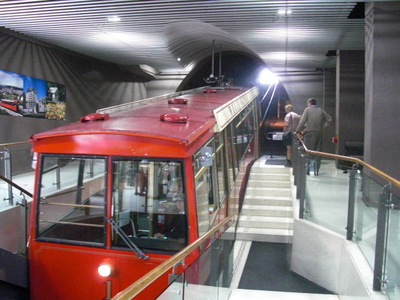
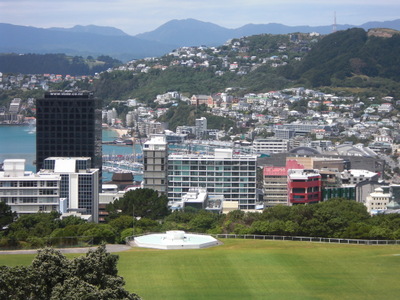 According to the brochure, I could catch a free shuttle for the seven-minute ride to Zealandia from the top of the cablecar, the sun was shining, and rain was predicted for the rest of the week, so I decided to do that first. The two photos show the cablecar as we boarded it at the bottom of the slope (left) and the view back toward the city from near the top (right). At the left-hand edge of the latter, you can see a little of the harbor and, if you know where to look, Te Papa at the edge of it. The octagonal white object at the bottom of the lawn is almost certainly the lid of a water reservoir. As is often done in England, they seem to have taken advantage of the steep terrain and put the water tower inside the hill— much less unsightly than America's erector-set water towers.
According to the brochure, I could catch a free shuttle for the seven-minute ride to Zealandia from the top of the cablecar, the sun was shining, and rain was predicted for the rest of the week, so I decided to do that first. The two photos show the cablecar as we boarded it at the bottom of the slope (left) and the view back toward the city from near the top (right). At the left-hand edge of the latter, you can see a little of the harbor and, if you know where to look, Te Papa at the edge of it. The octagonal white object at the bottom of the lawn is almost certainly the lid of a water reservoir. As is often done in England, they seem to have taken advantage of the steep terrain and put the water tower inside the hill— much less unsightly than America's erector-set water towers.
At the top terminal of the cablecar, I found a snack bar, a small cablecar museum, the grand entrance to the city's botanical gardens, and a paved circular drive, intended for pick-ups and drop-offs at the terminal. A prominent sandwich sign on the sidewalk advertised the free Zealandia shuttle, which I was annoyed to see ran only twice an hour (for a seven-minute trip?), at (strangely) 10 of and 10 after the hour. Rats, I had a 20-minute wait (the brochure said the walk was 20 minutes, so I decided to wait for the shuttle). On each side of the sign, four prominent arrows pointed to my left, flanking the instructions, "Please queue at the bus stop sign." Sure enough, five yards to my left was a sign saying "bus stop," but it was in blazing sunlight. Rather than stand there getting sunburned, I spent 10 of the 20 minutes doing a quick trip through the free museum and walking far enough into the botanical garden to see the observatory, which I chose not to visit. Still, I made sure to be back at the bus stop well before the shuttle was due—I was already running later than I'd hoped, and I really didn't want to miss it, so I hovered right by that sign, in the sun, for a good long time.
The van was late, but eventually it hove in sight, and I cheerfully stepped up to the curb to meet it, only to have it drive right by me, without a glance, continue around the circle, and head off into the distance, despite my shouting and hat waving in its wake. Angry? Livid does not begin to cover it! The nice young man at the cablecar museum was kind enough to let me use his cell phone and to dial up Zealandia for me. The receptionist there promised to call the shuttle driver and see if he could come back for me. He did, about 15 minutes later, and drove by me again!! But this time I was ready. I sprinted across the circle and more or less jumped in front of him, again waving my hat. "What do I have to do to get you to pick me up?! I've been waiting right by the bus stop sign!" Oh, that's a city bus stop. The Zealandia bus stop is over there, out of sight behind that tour bus that's been parked there all afternoon. I drove on past the bus, then looked back in my rear-view mirror; nobody was at the Zealandia stop, so I kept on going. "Why the [expletive deleted] does your sign point to the city bus stop?!" Oh, sometimes kids turn the sign around as a prank. And wasn't he going to turn it back? No point, it's almost the last run of the day. Needless to say, the comment section of the feedback card I filled out after my visit ran to several paragraphs.
I did learn, from the spiel the driver dutifully ran through for me, that I could have caught the shuttle directly at the I-Site or from Te Papa (a fact nowhere made clear on the website or in the brochures). The route is not a loop, accounting for the asymmetrical distribution of stop times at the cablecar terminal.
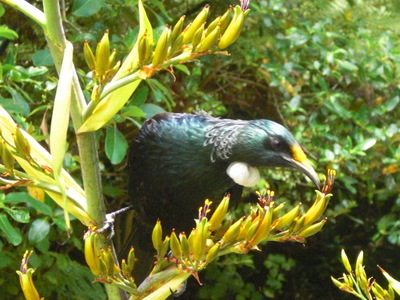
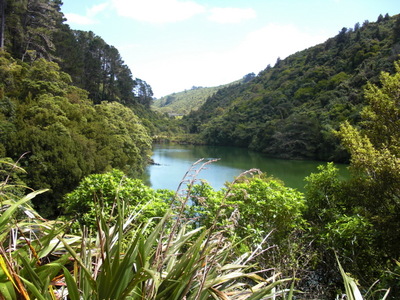 Once I finally got to the place and learned that I would in fact still have time to do the basic walking loop up to the upper dam and back, so long as I didn't dawdle too much on the way, I really enjoyed my visit.
Once I finally got to the place and learned that I would in fact still have time to do the basic walking loop up to the upper dam and back, so long as I didn't dawdle too much on the way, I really enjoyed my visit.
At the right is a tui, a very common native New Zealand bird. I saw them everywhere we went, but only at Zealandia could you walk right up and take photos like this. It's sipping nectar from a New Zealand flax flower. It's basically black, but with an iridescent sheen that makes it look metalic blue or green as the light shifts. The white things are a pair of little white plumes on its chest; an unmistakable mark of the species.
The basic premise of the place is to provide a predator-free zone for native animals. They've fenced in 225 ha of a river valley, encompassing the river, the lakes behind two dams, and the hillsides on either side, and they used a really serious fence. It's very tall (to keep out leapers like cats); extends downward for many feet into the soil (to keep out burrowers, like stoats and weasels); and is capped by a wide, recurved, metal baffle (that keeps out climbers like rats), and the vegetation has been cleared for several yards on either side of it (so that nothing can jump in from a neighboring tree). It keeps out all mammals except mice, which still compete with the natives for food, but they're working on that.
At the right above is one view of the lower lake. Beyond it, you can see the dam that contains the upper lake. On the lake, I saw several species of duck (the New Zealand scaups, Aythya novaeseelandiae, had half-grown ducklings) and two of cormorant.
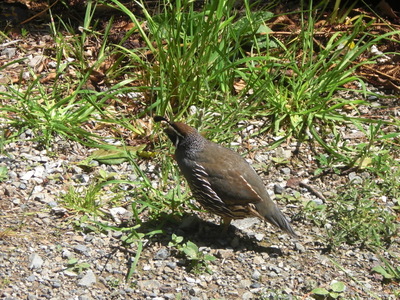
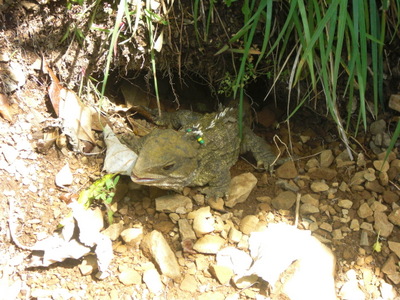 Within the predator-free zone, they've been able to reintroduce a number of native species otherwise extinct on the mainland and surviving only on offshore islands. Among them is the tuatara, a primitive reptile. The young (at least some of them) are kept in outdoor terraria, then released into the "wild." I think they're being kept within a smaller fenced enclosure until the population is well established, but maybe the fence was just part of the one for the takahes. As I was studying a baby tuatara in its glass enclosure, I happened to glance down to find, within a meter of my foot, this handsome California quail. It was accompanied by a single chick, and both were pecking around unconcernedly for seeds and whatnot. Clearly, even The Fence doesn't keep out nonnative birds. For both native and nonnative fauna, labels and information panels remind visitors to watch their step; I'm glad I spotted the chick before stepping on it! The preserve boasts several species of weta (large, flightless grasshopper-like insects), including rare giant wetas, which are out and about at night, so participants in the night tours are warned to be very careful not to crush them.
Within the predator-free zone, they've been able to reintroduce a number of native species otherwise extinct on the mainland and surviving only on offshore islands. Among them is the tuatara, a primitive reptile. The young (at least some of them) are kept in outdoor terraria, then released into the "wild." I think they're being kept within a smaller fenced enclosure until the population is well established, but maybe the fence was just part of the one for the takahes. As I was studying a baby tuatara in its glass enclosure, I happened to glance down to find, within a meter of my foot, this handsome California quail. It was accompanied by a single chick, and both were pecking around unconcernedly for seeds and whatnot. Clearly, even The Fence doesn't keep out nonnative birds. For both native and nonnative fauna, labels and information panels remind visitors to watch their step; I'm glad I spotted the chick before stepping on it! The preserve boasts several species of weta (large, flightless grasshopper-like insects), including rare giant wetas, which are out and about at night, so participants in the night tours are warned to be very careful not to crush them.
At the right is a larger, free-living tuatara. They can get to be a meter long, but this one was more like a foot. They seems to favor a particular bank, just inside a waist-high fence, for their burrows, so they're conveniently viewed from the footpath. I assume the little plastic beads attached to the nape of its neck are some sort of identification system, like bird bands.
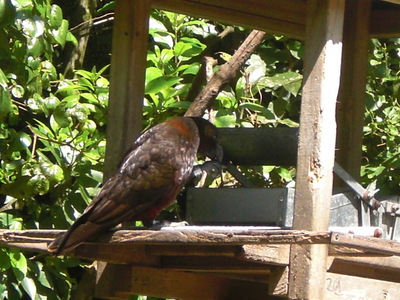
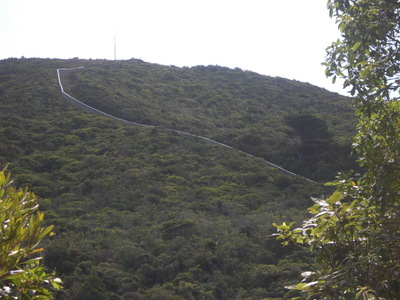 A species I had particularly hoped to see was the takahe (Porphyrio hochstetteri), a flightless rail two feet tall with a very heavy beak, looking like a brightly colored purple gallinule on serious steroids. They were thought to be extinct for about 50 years, before being rediscovered in a remote area of the south island (the north island species really is extinct). Unfortunately, because it was nesting season, they were in hiding. I was told that I could almost certainly get to see some if I waited by their feeding station, but alas, my late arrival didn't allow the time. The takahes are confined to a particular area within the preserve by a waist-high chain-link fence. A sign where the fence crosses the main footpath says, "Do not let takahe through this gate!" The area must be rather large, though, as I never crossed the fence again on my two-hour walking circuit, until I came back through that same gate at the end.
A species I had particularly hoped to see was the takahe (Porphyrio hochstetteri), a flightless rail two feet tall with a very heavy beak, looking like a brightly colored purple gallinule on serious steroids. They were thought to be extinct for about 50 years, before being rediscovered in a remote area of the south island (the north island species really is extinct). Unfortunately, because it was nesting season, they were in hiding. I was told that I could almost certainly get to see some if I waited by their feeding station, but alas, my late arrival didn't allow the time. The takahes are confined to a particular area within the preserve by a waist-high chain-link fence. A sign where the fence crosses the main footpath says, "Do not let takahe through this gate!" The area must be rather large, though, as I never crossed the fence again on my two-hour walking circuit, until I came back through that same gate at the end.
I did pause for a few minutes, though, at the kaka feeder (on the benches thoughtfully provided for the purpose). I could hear it long before I reached it—I thought someone must be building a new fence or some such, from the sound of hammer blows. The noise was actually made by the device intended to keep other species from stealing the kakas' food—square, compressed, inch-long pellets, presumably Purina Kaka Chow. When a kaka (Nestor meridionalis), a large brownish parrot, stepped up to one end of the double-ended feeder, it stepped on a bar, which its weight depressed to pop open the metal lid of the food bin. When it stepped back, the lid dropped shut again with a loud bang. Half a dozen kakas were making use of several feeders, all in the same clearing, keeping up a continuous fusilade of bangs. I wonder how long it took for the kakas to stop being alarmed by the noise. Below, on the ground a number of other species (mallards, European blackbirds, European sparrows) were busily harvesting the shards the parrots let drop. The kakas were actually more colorful than they look in my photo—like a brightly multicolored parrot that's been dipped in thin brown ink.
To the right of the kaka photo is a view of The Fence on the distant hillside across the river.
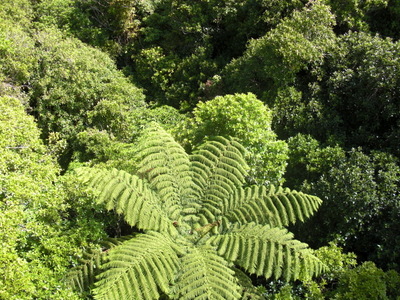
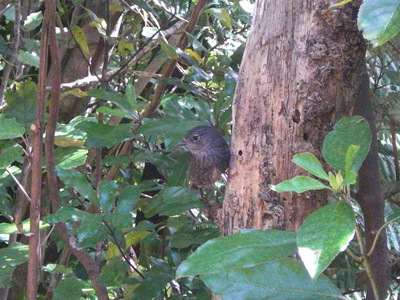 At one point, the trail crossed a suspension bridge. The photo at the left is a view downward onto a nice tree fern and its surrounding vegetation. At least I assume the trail I was supposed to be on crossed the bridge; I did, anyway. I came across many smaller side trails not marked on my map, and in addition, it was occasionally difficult, when the trail forked, to tell which was the main circuit. I was therefore "lost" several times, in the sense that I wasn't sure which trail would lead where I wanted to go, but I always knew where I was with respect to the valley and the visitor's center at the entrance—uphill was away from the river, downhill toward it, and you could frequently see a dam, the opposite hillside, or some other landmark. The trails were signposted, but not very informatively, IMHO.
At one point, the trail crossed a suspension bridge. The photo at the left is a view downward onto a nice tree fern and its surrounding vegetation. At least I assume the trail I was supposed to be on crossed the bridge; I did, anyway. I came across many smaller side trails not marked on my map, and in addition, it was occasionally difficult, when the trail forked, to tell which was the main circuit. I was therefore "lost" several times, in the sense that I wasn't sure which trail would lead where I wanted to go, but I always knew where I was with respect to the valley and the visitor's center at the entrance—uphill was away from the river, downhill toward it, and you could frequently see a dam, the opposite hillside, or some other landmark. The trails were signposted, but not very informatively, IMHO.
At the right is a North Island New Zealand robin (Petroica australis). On a long, straight stretch of "canopied" trail, where I found myself entirely alone, it flew down and lit in the middle of the path some yards ahead of me. I froze, brought my camera to the ready, and very, very slowly took a step toward it, hoping to get within range before it flew off. It looked up, spotted me, and came hopping right over to investigate! When it got closer, it fluttered up onto a tree trunk, about my meter from my face, and stood there sideways, looking at me with first one eye, then the other. You could almost hear it saying, "Oh, you've got a camera! Is this pose cute enough? How about this?"
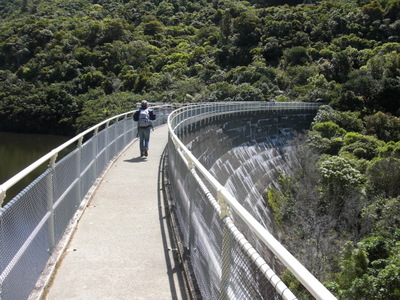
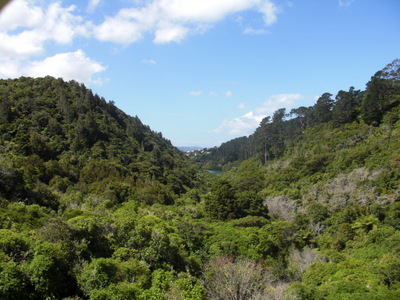 At the far end of the basic two-hour walking loop the trail led across the upper dam, which I crossed behind this other walker, who arrived just before I did, but by a different route. If you want, and have time, you can walk twice as far again around the upper lake and beyond or up onto the flanking hillsides, which are crisscrossed with trails.
At the far end of the basic two-hour walking loop the trail led across the upper dam, which I crossed behind this other walker, who arrived just before I did, but by a different route. If you want, and have time, you can walk twice as far again around the upper lake and beyond or up onto the flanking hillsides, which are crisscrossed with trails.
At the right is the view down the valley from the center of the dam. You can see a little of the lower lake and a few houses beyond, outside the preserve. Wellington city is hidden behind the hills on the right.
Throughout the preserve, you come to little signs telling you which individual kiwi's territory you are currently entering or leaving. The kiwis have names ranging from "Fred" to "XJ719," and if you sign up for a nighttime tour, you are apparently assured of seeing them out foraging in their native habitat.
The work of keeping the preserve predator-free is never-ending. The managers constantly monitor by means of "ink traps," baited boxes intended to draw wildlife to walk through them. Their floors are covered with inked pads and white paper, so that whatever walks, crawls, or slithers through leaves foot (or other) prints, from which it can be identified. If an undesirable visitor is detected, the managers then know what kind of live trap to use to catch it and dispose of it. They use only live traps because of the danger of catching desirables, as well. At the entrance/exit, visitors go through a sort of airlock-chamber arrangement. Signs warn that you shouldn't open the second door until the one behind you is fully closed and you've verified that nothing unwanted has come into the chamber with you.
I got back to the visitors' center, just outside the fence, in time to take a quick turn through its museum. It has a life-size audioanimatronic moa (of the largest species—apparently they came in many sizes) and a model of the amazing New Zealand eagle, which had a 3-meter wingspan and could take down adult moas. In fact, that's all it ate, so when they went extinct, so did the eagle.
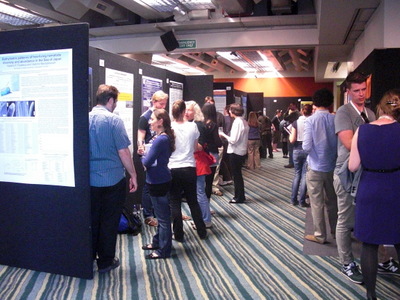
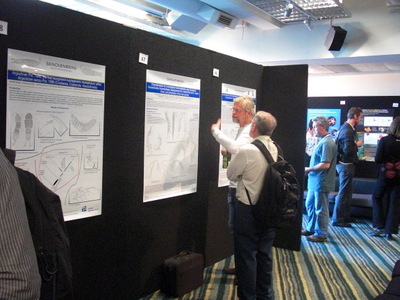 I caught the last shuttle of the day and stayed on board all the way to Te Papa. Coincidentally, my seatmate was on her way home after her first day as a volunteer in the PR department and was eager to hear my many suggestions for better publicity about the shuttle, getting info to Americans, etc.
I caught the last shuttle of the day and stayed on board all the way to Te Papa. Coincidentally, my seatmate was on her way home after her first day as a volunteer in the PR department and was eager to hear my many suggestions for better publicity about the shuttle, getting info to Americans, etc.
I got back to the meeting just as the last talk session ended and poster session began. As you can see from the photo on the left, the venue was a very good size. Everyone had plenty of room to circulate among the rows of posters, the food was good, and discussion was lively. At the right, colleague Kai George explains his row of three posters to David. Both are working, by different approaches, on the problem of the size of species ranges in the deep sea.
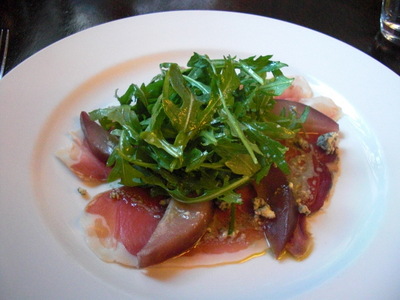
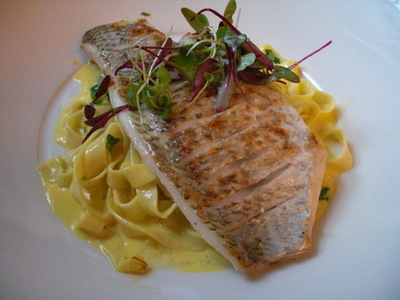 After the poster session, we walked a few blocks inland for dinner at Zibibbo, on Taranaki Street, where we ordered the special prix fixe menu and both chose the same items (of a choice of two) for the three courses.
After the poster session, we walked a few blocks inland for dinner at Zibibbo, on Taranaki Street, where we ordered the special prix fixe menu and both chose the same items (of a choice of two) for the three courses.
First course: Parma ham with wine-poached pear slices, crumbled blue cheese, and arugula salad.
Main course: Wood-roasted tarahiki (a fish, Nemadactylus macropterus) with fresh linguine and saffron-lemon beurre blanc.
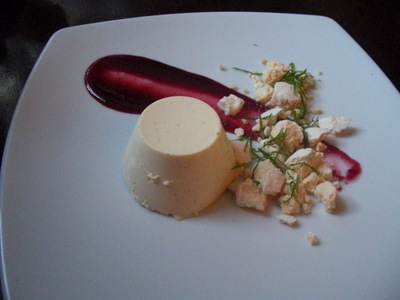
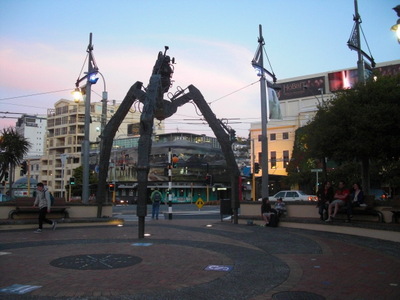 Dessert: Vanilla-bean panna cotta with berry sauce, crushed meringue, and mint.
Dessert: Vanilla-bean panna cotta with berry sauce, crushed meringue, and mint.
We strolled back to the hotel via Courtenay Place, where I got this shot of a local landmark, the sculpture called "the Tripod," made up of scrap metal and old cinematography equipment and commemorating the local film industry. Part of the bank of vegetation at the right is real (a street tree), but the rest of is part of the elaborately decorated movie-theater facade, decked out for the Hobbit premiere; the huge statue of Gandalf is hidden by the tree. Our hotel is the white building at the left, partially obscured by the palm tree.